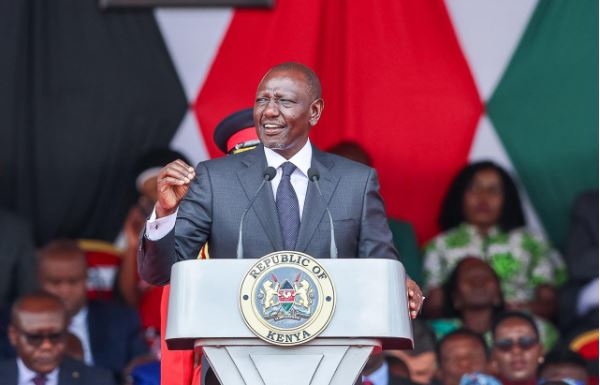Two hundred and seventy three elephants have died due to drought according to the latest statistics.
A Kenya Wildlife Services official who spoke on anonymity has said the situation is worsening. Officials manning Kenya's iconic species are set to brief President William Ruto.
Tsavo is the worst affected, 81 elephants have died followed by Samburu with 67 and Isiolo with 57.
“In the Amboseli ecosystem, we have lost 22 and in Laikipia 36,” the official said.
“Ten elephants have died in Marsabit and 400 Zebras.”
The drought has not spared other species such as giraffes, buffaloes, and wildebeest.
However, we could not obtain the recent statistics of other affected wildlife species by the time of going to the press.
The loss, ecologists say will lead to an imbalance in the ecosystem.
“The best genes may be lost as the ongoing drought does not select,” Kenneth Kimitei, an ecologist based at the Tsavo-Mkomazi landscape said.
Kimitei said when the drought affects herbivores, the food base for carnivores is affected.
He said the weak and the sick wildlife are affected by the ongoing drought.
Kimitei said carcasses are breeding grounds for pests and diseases, and risk spreading including East Coast Fever.
He said scavengers such as hyenas will feed on carcasses before moving to other places.
Jumbos play a key role in tourism and conservation and their deaths are a big blow to some of the country’s ecosystems.
The Jumbos are referred to as keystone species, playing an important role in maintaining the biodiversity of the ecosystems in which they live.
During the dry season, elephants use their tusks to dig for water, a move that allows them and other species in the wild to survive.
As forest elephants eat, they create gaps in the vegetation, allowing new plants to grow and creating pathways for other, smaller animals to use.
They are also one of the major ways in which trees disperse their seeds, some species rely entirely upon elephants for seed dispersal.
According to census results released last year, there are 36,280 jumbos.
This means that the country now has less than 36,000 elephants as some might have died due to natural causes since when the national census was held.
The census was launched on May 7 last year at Shimba Hills National Reserve in Kwale.
Some of the iconic species counted were black rhinos (897), white rhinos (842), northern rhinos (2), lions (2,589), hyenas (5,189), cheetahs (1,160), wild dogs (865), buffalo (41,659).
Others counted include Maasai giraffe (13,530), reticulated giraffe (19,725), Nubian’s giraffe (938), common zebra (121,911), Grevy’s zebra (2,649), eland (13,581), hartebeest (7,332), wildebeest (57,813), and Grant’s gazelle (66,709).
Thomson’s gazelle (18,277), Hirola (497), Topi (8,627), Impala (25,541), Oryx (11,765), Kudu (2,524), Gerenuk (13,400), Waterbuck (1,071), Warthog (8,013), Hippo (1,788), Maasai Ostrich (2,354), Somali Ostrich (6,483), Roan Antelope (15), Sable Antelope (51), and Mountain Bongo (150) were counted.
The ongoing drought has resulted in the dispersal of wildlife from their traditional habitats in search of pasture and water, a move that has increased human-wildlife conflicts.
Some conservation NGOs such as the Grevy’s Zebra trust have resorted to feeding an average of 489 Grevy’s a day. They have distributed 3,445 bales of hay.
The NGO says it has lost 79 Zebras so far. Nine have died this week alone.
Based in remote Northern Kenya, the NGO says 38 per cent of Grevy’s zebras are targeted as they are lactating mothers and foals.
Conservationists are now warning that without concrete solutions, the future of Kenya's iconic species is at stake.
WildlifeDirect CEO Paula Kahumbu said the drought was predicted well before it became catastrophic.
Kahumbu said the government should have listened to experts and planned how to protect livestock.
She said the state should have immediately initiated efforts to buy livestock to prevent the loss of livelihoods.
“Some animals like elephants are dying because there is just no food and they cannot move due to constraints like fences. The government should immediately take steps to secure wildlife buffer zones and dispersal areas,” she said.
Kahumbu said there is little they can do to save Elephants now.
“They need far too much. For endangered species like the Grevy's, the government can support with grass and water,” she said.
Kahumbu said the government should for now look into the devastating effect of water abstraction in rivers, the fences and farms in wildlife dispersal areas.
“The spatial land use plan needs to be strictly enforced and people rewarded for successful efforts,” she said.
Conservation Alliance of Kenya Board chairperson Lucy Waruinge termed the current drought as severe.
Waruinge said there are carcasses of wildebeest, zebra and elephants littering parts of Amboseli.
In the Amboseli ecosystem, it is estimated that over 150,000 cattle had moved into the region from across southern Kenya and northern Tanzania.
The drought in 2009 is estimated to have amounted to over Sh3 billion in livestock losses in Amboseli alone.
By late September, wildebeest deaths in the ecosystem were around 10 per cent of the population and zebra 6 to 7 per cent in the ecosystem.
Waruinge said the verified deaths of wildlife species including elephants in the Amboseli ecosystem as from June to date due to drought is about 90.
Comparing the current drought to 2009, Waruinge said there are salient points that emerge.
Waruinge said in early October 2009 over 55 per cent of the wildebeest and 40 per cent of the zebra had died.
This is in comparison to 20 per cent of wildebeest and 10 per cent of zebra that had died by the same period in 2022.
She said the move suggests that the losses will be far less than in 2009.
Edited by Kiilu Damaris












